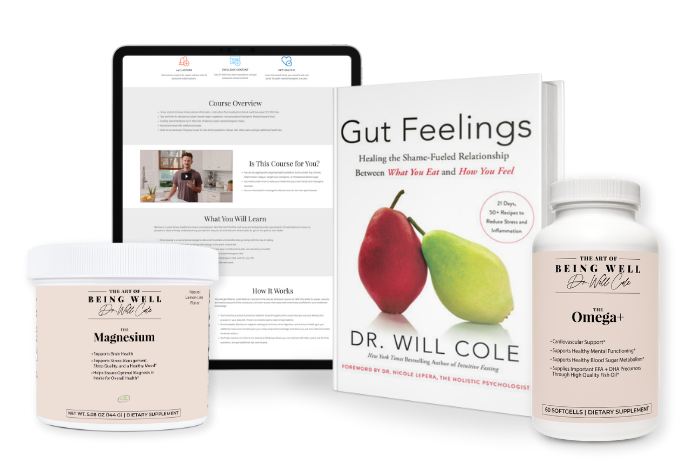12 Of The Most Common Food Intolerances

A “one-size-fits-all” diet would be nice, but some people experience allergies, sensitivities, or intolerances to foods that are both common and healthy.
And they often go undetected.
Food intolerances and sensitivities are different from allergies. A food allergy is a harmful — sometimes life-threatening — health effect caused by the immune system's response to a specific food (1).
On the other hand, food intolerance is a nonimmune response to a specific food from the body, which is often more subtle or harder to pinpoint, but which can lead to chronic inflammation and different kinds of symptoms and health problems over time.
There are a handful of foods that are most likely to be problematic. Let’s take a look at some of the common food intolerances that I see the most often in my telehealth functional medicine clinic.
1. Dairy
Lactose intolerance is one of the most common food intolerances out there. Lactose intolerance occurs when your body cannot digest lactose, a sugar in milk and dairy products. (2) This inability to digest lactose is also sometimes called lactose malabsorption. A lack of lactase enzymes in the body causes this inability to digest lactose. (3)
Lactose intolerance generally causes digestive symptoms like bloating, diarrhea, and gas.
Lactose intolerance is different from a milk allergy. A milk allergy is an allergic reaction to casein and/or the other proteins in milk and dairy products. (4)
Many people also have sensitivities to casein or other milk proteins — not a true allergy, but an inflammatory reaction that can trigger different kinds of symptoms.
There are other reasons to be cautious about dairy consumption. Since most dairy farm cows are given hormones & antibiotics, unclean living conditions, and bad feed, their milk is typically pasteurized (superheated), homogenized (blended), and fat is often removed.
To make up for this processed product having so little nutrition, synthetic vitamins are added back into the milk in an attempt to simulate what was included in its whole-food form.
Organic dairy is generally a better choice because it does not allow hormones and antibiotics. Fermented dairy, such as grass-fed kefir and yogurt, is even better, as it mitigates some of the problems people have with casein sensitivity. It also includes probiotics (beneficial bacteria) which may help to offset inflammatory reactions in the gut.
2. Gluten
Gluten – the protein that’s found in grains like wheat, rye, and barley – is another one of the most common food sensitivities that I see.
To understand gluten intolerance, we need to understand autoimmunity. Many people think when we talk about gluten intolerance, we are referring to the autoimmune condition celiac disease. Yes, celiac is an autoimmune disease, but it is the extreme end of a broader gluten-intolerance spectrum. (5)
Related: The Negative Effects Of Gluten + The Best Way To Go Gluten-Free
You can be on the autoimmune-inflammation spectrum without having celiac disease, and that can result in gluten intolerance or non-celiac gluten sensitivity (NCGS). You may not have tests that come back saying you have a specific autoimmune disease, but I believe that gluten reactivity is a warning you could eventually be headed in that direction if you don’t change your diet and health habits.
Interested in taking action for your autoimmune condition? Check out my video course on Mastering Autoimmune Conditions & Inflammation With Functional Medicine.
Those who avoid gluten but still have symptoms may be grain-intolerant, even when those grains are gluten-free. You may have a sensitivity to one particular grain or all grains.
Many (but not all) of my patients have sensitivities to some gluten-free grains.
Cross-reactivity occurs when the proteins in grains such as rice and corn and in some non-grain foods are similar enough in structure to gluten that the body mistakes them and reacts as if they were gluten.
Some other potentially cross-reactive foods include:
- Gluten-free grains
- Milk and dairy products
- Soy
- Coffee
- Chocolate
- Eggs
3. FODMAPs
FODMAPs stands for Fermentable Oligosaccharides, Disaccharides, Monosaccharides, and Polyols. In short: a group of fermentable sugars. These short-chain carbohydrates are found in many different foods and are not fully digested. Instead, they are fermented by gut bacteria.
This is fine for most people, but for those with a bacterial overgrowth or other imbalances, this can exacerbate the problem by feeding excess bacteria.
The fermentation of FODMAPs releases hydrogen gas that could lead to distension of the intestines, which can cause uncomfortable irritable bowel syndrome (IBS) symptoms in some people, such as pain, gas, bloating, constipation, and diarrhea. FODMAP intolerance tends to be related to functional issues like small intestinal bacterial overgrowth (SIBO).
Most high-FODMAP foods are actually healthy, whole foods. Again, though, that doesn’t mean they work well for everyone. If you think you are FODMAP intolerant, try avoiding the following foods – at least temporarily – to see if it helps:
- Certain vegetables: Artichokes, asparagus, beetroot, celery, garlic, onions, leek bulb, legumes, Savoy cabbage, sugar snap peas, sweet corn
- Certain fruits: Apples, mango, nectarines, peaches, pears, plums, watermelon
- Dairy: Milk, cream, custard, ice cream, soft cheeses, yogurt
- Grains: Rye, wheat-containing breads, cereals, crackers, pasta
- Some nuts: Cashews, pistachios
The goal of treating a FODMAP intolerance is not to remove the trigger foods forever but to heal the gut so you can eventually increase your intake of these particular foods. This is especially true when it comes to high-FODMAP fruits and vegetables, which are valuable sources of nutrients.
Listen: How FODMAP Intolerance & SIBO Hurt Our Mood & Gut Health + What To Do About It
4. Fructose
Fructose, one of the FODMAP sugars, is also a relatively common intolerance on its own. Fructose intolerance occurs when the body lacks the enzymes needed to breakdown fructose. (6) This causes a build up of fructose, which is toxic to the liver.
Fructose is found most abundantly in fruits, fruit juices, and sweeteners. Some vegetables are also high in fructose.
Pears, watermelon, apples, asparagus, and peas are some of the healthy foods that naturally contain high amounts of fructose. Honey, agave syrup, and maple syrup are also high fructose.
Of course, I would recommend always avoiding high-fructose corn syrup, regardless of whether or not you have a fructose intolerance.
5. Histamine
A histamine intolerance occurs when your body either doesn't produce enough of the enzymes needed to break down histamines, it releases excess histamine from mast cells, or both.
Your body releases histamines naturally in response to allergens. Many foods also contain histamines or cause a release of more in your body. Histamine intolerance happens when there's an imbalance between the amount of histamine in your system and your body's ability to break it down.
Histamine intolerance often presents like an allergic reaction but without the allergen. The symptoms may be similar to those of other allergic reactions (e.g. runny nose, nausea, headache, fatigue, etc.). However, some people experience different kinds of symptoms related to inflammation throughout the body.
Learn more: Histamine Intolerance: Causes, Symptoms, and Natural Treatments
6. Eggs
Eggs contain so many nutrients, especially in the yolk, but that doesn’t mean this food isn’t problematic for some people. In my experience, it is actually the egg white that is typically more immunoreactive for people.
Ovalbumin, a protein in the white, is one of the most common allergens. (7) The yolks are generally better tolerated, although it’s important to note that some people can’t handle the yolk, either.
7. Nuts And Seeds
If you experience symptoms after consuming nuts or seeds, you may have a salicylate intolerance. Salicylate acid is a compound found in plants such as legumes and tree nuts (e.g. peanuts). (8) Many of the common symptoms of this intolerance are respiratory, but other symptoms including headaches and hives are also possible.
8. Caffeine
Caffeine sensitivity is when a person experiences stronger reactions to caffeine than most people, often due to genetic factors. (9) It can lead to symptoms such as restlessness, anxiety, rapid heartbeat, or insomnia – even with small amounts of caffeine.
The body's ability to metabolize caffeine varies, and those with higher sensitivity break it down more slowly, causing the effects to last longer. Reducing caffeine intake is an easy way to start managing this intolerance.
9. Alcohol
Regular consumption of alcohol has the potential to negatively influence almost every system in your body. For the gastrointestinal system in particular, alcohol can be a trigger for leaky gut syndrome and gut inflammation..
Some people also have an intolerance to the sulfites (food additives) found in most beer, ciders, and wines. (10) This intolerance can cause asthma, skin rashes, or gastrointestinal distress. Sulfites may cause reactions by releasing sulfur dioxide that irritates the lungs and digestive tract. People with asthma or certain enzyme deficiencies are more susceptible to sulfite sensitivity.
Wine and beer are also high in histamine, and are likely to trigger reactions for those with histamine intolerance.
10. Nightshades
A plant group that consists of tomatoes, peppers, potatoes, eggplant, goji berries, and some spices containing alkaloids, nightshades can be inflammatory for many people. These alkaloids act as a natural pesticide to keep bugs and mold away from the plants. The small amounts of alkaloids in edible nightshades are not enough to harm humans.
However, specific people can be more sensitive to alkaloids and thus be intolerant to these foods. Nausea, vomiting, inflammation, brain fog, migraines, acne, rashes, hives, and achy joints after eating nightshades are all signs and symptoms of this type of sensitivity.
11. Sugar
Sugar is the favorite food of more pathogenic gut bacteria that can cause many gastrointestinal problems. This means that when you eat sugar, you are feeding the bad gut bacteria so that they may crowd out the good bacteria that actually support your gut and overall health.
An imbalance of bacteria in your gut can also lead to negative effects on your body’s metabolism and immune responses. (11) Overgrowth of bad (sugar-loving) bacteria can also cause inflammation, eventually leading to an autoimmune-inflammatory response.
Research shows that artificial sweeteners also decrease the good bacteria in the gut, which could also cause glucose intolerance and lead to diabetes. (12)
Read More: How To Heal Your Gut: A Complete Functional Medicine Guide To Restoring Microbiome Health
12. Shellfish
Reactions to shellfish are caused by the body not having the enzymes to break down the proteins in shellfish. (13) Shellfish reactions can be either an intolerance or an allergy. Additionally, some people specifically have reactions to crustaceans (e.g. shrimp and crab) and/or mollusks (e.g. clams and scallops).
Symptoms that indicate you might be experiencing a shellfish sensitivity are typically digestive and can include abdominal pain, bloating, nausea, vomiting, and diarrhea.
Symptoms To Watch For
Some of the most common symptoms of food intolerances include (2,6,9,10)
- Bloating
- Gas
- Fatigue
- Abdominal pain
- Diarrhea
- Nausea
- Restlessness
- Nervousness or anxiety
- Rapid heart rate
- Insomnia
- Upset stomach
- Headaches
- Skin reactions (e.g. hives)
- Respiratory issues (e.g. asthma)
- Dizziness
Food Intolerance Testing
One of the most common ways of testing is an Immunoglobulin Test (IgG Test). This test is done by an at-home finger-prick test or a lab blood draw. The sample is then tested for IgG food or drink antibodies within the blood. However, this kind of testing doesn't identify all kinds of sensitivities and intolerances, as not all sensitivities and intolerances are IgG mediated.
An elimination diet is another great way to determine if you have an intolerance. Simply remove a certain food (or many) from your diet for a period of time and start to reintroduce the suspected trigger foods one at a time. Watch for reactions and signs of intolerance as you add back the foods you eliminated.
If you have a suspicion about which kinds of foods you may be sensitive to, you can do a more specific kind of elimination diet (for example, a low histamine or low FODMAP diet, or gluten cross-reactive testing, in which you consume foods with proteins that are similar to gluten or that are cross-reactive with gluten).
Read More: Your Complete Functional Medicine Guide To At-Home Food Intolerance Testing
Don’t Know Where To Start? We Can Help
If you're experiencing chronic symptoms and you're not sure why, or think you may have a food intolerance, we can help you determine exactly what foods could be the cause. We aim to provide an individualized approach for you and your unique symptoms and needs.
As one of the first functional medicine telehealth clinics in the world, we provide webcam health consultations for people around the globe.
FAQ
A food intolerance may suddenly appear if you have experienced a change that has made your body unable to produce the enzymes needed to digest the trigger food. Examples of this change may be surgery, a stressful event, an illness, or even just aging.
Lectins are proteins found in many plants that cling to carbohydrates. A lectin intolerance is a nonimmune reaction to these proteins from your body due to an inability to digest lectins.
The 5 most common food intolerances rank as follows:
- Dairy/Lactose
- Gluten
- Eggs
- Caffeine
- Salicylates
View More At Our Store
Purchase personally curated supplements
and Dr. Will Cole’s books!

-
- Gargano, D., Appanna, R., Santonicola, A., De Bartolomeis, F., Stellato, C., Cianferoni, A., ... & Iovino, P. (2021). Food allergy and intolerance: A narrative review on nutritional concerns. Nutrients, 13(5), 1638.
- National Institute of Diabetes and Digestive and Kidney Diseases. (n.d.). Definition & facts for lactose intolerance - niddk. National Institute of Diabetes and Digestive and Kidney Diseases.
- Mattar, R., de Campos Mazo, D. F., & Carrilho, F. J. (2012). Lactose intolerance: diagnosis, genetic, and clinical factors. Clinical and Experimental Gastroenterology, 113-121.
- Edwards, C. W., & Younus, M. A. (2019). Cow milk allergy.
- Sapone, A., Bai, J. C., Ciacci, C., Dolinsek, J., Green, P. H., Hadjivassiliou, M., ... & Fasano, A. (2012). Spectrum of gluten-related disorders: consensus on new nomenclature and classification. BMC Medicine, 10, 1-12.
- Hegde, V. S., & Sharman, T. (2020). Hereditary fructose intolerance.
- Mathew, P., & Pfleghaar, J. L. (2019). Egg allergy.
- Duthie, G. G., & Wood, A. D. (2011). Natural salicylates: foods, functions and disease prevention. Food & Function, 2(9), 515-520.
- Landolt, H. P. (2012). “No thanks, coffee keeps me awake”: individual caffeine sensitivity depends on ADORA2A genotype. Sleep, 35(7), 899-900.
- Vally, H., & Misso, N. L. (2012). Adverse reactions to the sulphite additives. Gastroenterology and Hepatology from Bed to Bench, 5(1), 16.
- Payne, A. N., Chassard, C., & Lacroix, C. (2012). Gut microbial adaptation to dietary consumption of fructose, artificial sweeteners and sugar alcohols: implications for host–microbe interactions contributing to obesity. Obesity Reviews, 13(9), 799-809.
- Suez, J., Korem, T., Zeevi, D., Zilberman-Schapira, G., Thaiss, C. A., Maza, O., ... & Elinav, E. (2014). Artificial sweeteners induce glucose intolerance by altering the gut microbiota. Nature, 514(7521), 181-186.
YorkTest US. (2023) Shellfish intolerance and sensitivity: Signs & symptoms. YorkTest US.
The information on this website has not been evaluated by the Food & Drug Administration or any other medical body. We do not aim to diagnose, treat, cure or prevent any illness or disease. Information is shared for educational purposes only. You must consult your doctor before acting on any content on this website, especially if you are pregnant, nursing, taking medication, or have a medical condition.
Our content may include products that have been independently chosen and recommended by Dr. Will Cole and our editors. If you purchase something mentioned in this article, we may earn a small commission.

BY DR. WILL COLE
Dr. Will Cole, DNM, IFMCP, DC is a leading functional medicine expert who consults people around the globe, starting one of the first functional medicine telehealth centers in the world. Named one of the top 50 functional and integrative doctors in the nation, Dr. Will Cole provides a functional medicine approach for thyroid issues, autoimmune conditions, hormonal imbalances, digestive disorders, and brain problems. He is also the host of the popular The Art of Being Well podcast and the New York Times bestselling author of Intuitive Fasting, Ketotarian, Gut Feelings, and The Inflammation Spectrum.

Gut Feelings
Healing The Shame-Fueled Relationship
Between What You Eat And How You Feel


